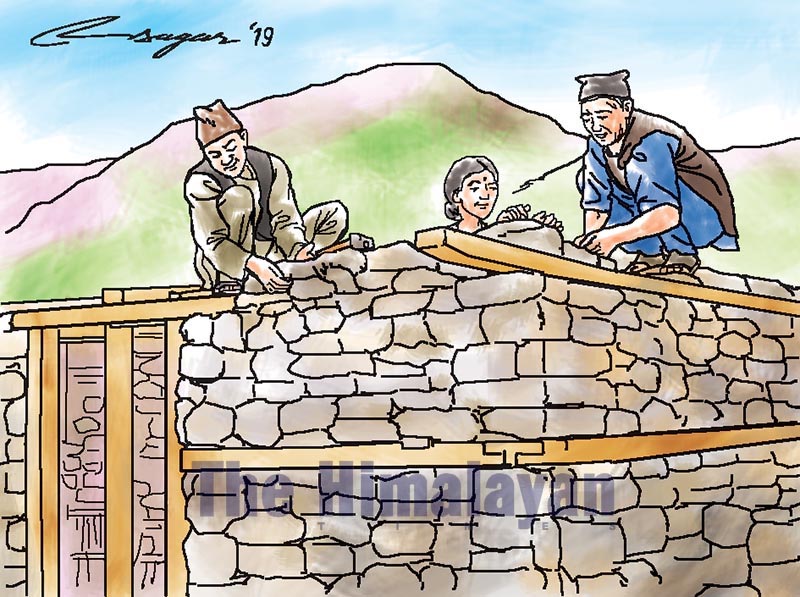Earthquake reconstruction: Challenge to save social aura
The government-approved house map for the quake-hit areas should be designed by analysing the socio-cultural and geographical context. Following the Gorkha quake, people decided on RCC construction because they thought it was safer
Nepal is multi-hazardous country, and the government has been implementing a National Disaster Risk Reduction (DRR) Act since 2018 in line with the global plan of Sendai Framework for Disaster Risk Reduction 2018-2030. The impact of climate change has been directly and indirectly seen in the country, with reoccurrences of mini-typhoons, drought, heavy rains, extreme heat and thunderbolt. Similarly, Nepal was witness to a strong earthquake in 2015.
Earthquake reconstruction is running in its fifth year. Retrofitting and new construction have been rapidly moving ahead. With federalism in place, the local authority has taken up the major responsibility of earthquake reconstruction. Proper implementation of earthquake-resistant construction practices and their institutionalisation are a burning issue in the quake-hit districts.
The data of the National Reconstruction Authority (NRA) show that almost 62 per cent of housing construction has been completed till now. According to the Post Disaster Need Assessment (PDNA) report, more than 850,000 residential buildings, 5,000 schools and 1,000 health facilities were damaged in the Gorkha Earthquake-2015. In addition, government and public buildings were also damaged on a massive scale. NRA has a plan to complete and achieve the targeted goal of reconstruction by January 2020.
Supporting the mission of the government are numerous I/NGOs in different districts. The government has provided a housing grant of $3,000 to each affected family, which has still not been taken by all those entitled due to socio-cultural difficulties and challenges faced in housing construction. There is difficulty in managing construction materials and workers in housing construction while lack of trained technical manpower is another challenge. The approval of housing design is highly complex for particular target groups as the nation’s geographical and socio-cultural diversity demands diversity in construction design and approach.
RCC construction is the current mode of construction, which is expensive and costly for the people of the rural areas. Also, the procurement, transportation of construction materials and workmanship make housing construction expensive. The overall construction or maintenance cost is high, and the subsidy doesn’t cover even 50 percent of the cost. In the hilly and mountainous districts, transportation of construction materials is difficult during the monsoon, and there is water scarcity for construction in the winter season. So the use of local materials is far better than adopting modern construction materials and technology.
Hence, user-friendly or community-friendly designs are a must for rural reconstruction. A few settlements and communities are building houses to fulfill the reconstruction ritual. Such buildings have one or two rooms, making it difficult to meet the needs of a family.
On the other hand, high-rise apartments are coming up in the semi-urban and urban settlements. These constructions clearly exceed the height recommended in the country’s seismic building code, underlining the challenge of enforcing implementation. There is a clear gap between the haves and have nots, which is impacting the reconstruction process and progress. The government has been implementing the Building Code since 2003, but is still facing difficulty in implementing it in the field, so necessary to reduce the disaster risks.
Earlier construction practices of Nepal were unique in architecture. The traditional roofing, artistic wooden frame and design were typical. They were geographically and socio-culturally friendly but vanished in the post-earthquake reconstruction. The straw and stone slate roofing has given way to concrete construction, in which Nepali originality and socio-cultural diversity have been lost. Thus, the traditional aura in a building has been lost. From the eyes of social science or sociological perspective, this is a critical issue that has been raised in earthquake reconstruction.
Therefore, the government has to frame a strategy to use local materials rather than the RCC model for housing construction. The government-approved house map for the quake-hit areas should be designed by analysing the socio-cultural and geographical context. Following the Gorkha Earthquake, the beneficiaries decided on RCC construction because they thought it was safer than masonry work. But senior engineers and DRR experts claim that masonry buildings can easily resist an earthquake just like the RCC. Certainly, our ancestors designed and constructed buildings that were geographically and socio-culturally-friendly, which were beautiful, environment-friendly and healthy to live in. Therefore, the Himal, Tarai and Hilly regions have their unique types of construction practices, and the local authority has to take the lead in protecting the local cultural diversity.
In the post-quake reconstruction, entire settlements have migrated to the urban areas or cities of concrete. Interestingly, the government is planning 2020 as tourism year, but the originality of settlements is being lost day by day. Therefore, to maintain the aura, originality and glory of a community, citizens must share some responsibility, and the local authority has to develop a certain code for housing construction and land plotting.






